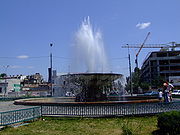
Carol Park
Encyclopedia
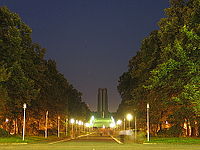
Bucharest
Bucharest is the capital municipality, cultural, industrial, and financial centre of Romania. It is the largest city in Romania, located in the southeast of the country, at , and lies on the banks of the Dâmbovița River....
, Romania
Romania
Romania is a country located at the crossroads of Central and Southeastern Europe, on the Lower Danube, within and outside the Carpathian arch, bordering on the Black Sea...
, named after King Carol I of Romania
Carol I of Romania
Carol I , born Prince Karl of Hohenzollern-Sigmaringen was reigning prince and then King of Romania from 1866 to 1914. He was elected prince of Romania on 20 April 1866 following the overthrow of Alexandru Ioan Cuza by a palace coup...
. For the duration of the communist regime
Communist Romania
Communist Romania was the period in Romanian history when that country was a Soviet-aligned communist state in the Eastern Bloc, with the dominant role of Romanian Communist Party enshrined in its successive constitutions...
, it was called Liberty Park (Parcul Libertăţii).
The park was designed by French
French people
The French are a nation that share a common French culture and speak the French language as a mother tongue. Historically, the French population are descended from peoples of Celtic, Latin and Germanic origin, and are today a mixture of several ethnic groups...
landscape art
Landscape art
Landscape art is a term that covers the depiction of natural scenery such as mountains, valleys, trees, rivers, and forests, and especially art where the main subject is a wide view, with its elements arranged into a coherent composition. In other works landscape backgrounds for figures can still...
ist Édouard Redont in 1900 on Filaret Hill and inaugurated in 1906. The park had an initial surface area of 360,000m², with a 20,000m² lake in the middle. It is officially recognized as a historical monument and is therefore protected by law. Administration of the park is undertaken mostly by the Bucharest City Hall
Mayor of Bucharest
The Mayor of Bucharest , sometimes known as the General Mayor, is the head of the Bucharest City Hall in Bucharest, Romania, which is responsible for city-wide affairs, such as the water system, the transport system and the main boulevards...
, whereas monuments are in the care of the Ministry of Culture and Religious Affairs.
Attractions
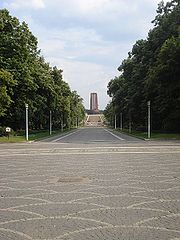
Tomb of the Unknown Soldier in Bucharest
The Tomb of the Unknown Soldier is a monument located in Bucharest, dedicated to the soldiers who died while fighting for Romania. It is one of many such national tombs.It was built in 1923 to commemorate the Romanians who died during World War I....
and a mausoleum where some of Romania's most prominent Communist
Romanian Communist Party
The Romanian Communist Party was a communist political party in Romania. Successor to the Bolshevik wing of the Socialist Party of Romania, it gave ideological endorsement to communist revolution and the disestablishment of Greater Romania. The PCR was a minor and illegal grouping for much of the...
leaders were buried until the Romanian Revolution of 1989
Romanian Revolution of 1989
The Romanian Revolution of 1989 was a series of riots and clashes in December 1989. These were part of the Revolutions of 1989 that occurred in several Warsaw Pact countries...
.
Other attractions include the Cantacuzino
Cantacuzino family
The Cantacuzino or Cantacuzène family is an old boyar family of Wallachia and Moldavia, a branch of Greek Kantakouzinos family, allegedly descended from the Byzantine Emperor John VI Cantacuzenus. No definite genealogical links between Byzantine Greek and Romanian Cantacuzinos have been established...
Fountain, the Giants' Statues, the Zodiac Fountain, the Technical Museum (first opened in 1909), a monument in the shape of a small mosque built in 1923 as a sign of reconciliation, the open-air Roman Arena, and the Astronomical Institute of the Romanian Academy
Romanian Academy
The Romanian Academy is a cultural forum founded in Bucharest, Romania, in 1866. It covers the scientific, artistic and literary domains. The academy has 181 acting members who are elected for life....
.
The park once contained busts of Ioan Lahovari and Constantin Istrati
Constantin Istrati
-Sources:*...
, but these are now gone. After 1948, busts of George Coşbuc
George Cosbuc
George Coşbuc was a Romanian poet, translator, teacher, and journalist, best remembered for his verses describing, praising and eulogizing rural life, its many travails but also its occasions for joy....
, Alexandru Sahia
Alexandru Sahia
Alexandru Sahia was a Romanian communist journalist and short story author.-Early life:...
, Nicolae Bălcescu
Nicolae Balcescu
Nicolae Bălcescu was a Romanian Wallachian soldier, historian, journalist, and leader of the 1848 Wallachian Revolution.-Early life:...
(these three by Constantin Baraschi) and Theodor Neculuţă (by E. Mereanu) were set up in the park, where they remain.
In 2006, the Tomb of the Unknown Soldier was relocated to its original 1923 location, somewhat closer to the former communist mausoleum.
Mausoleum
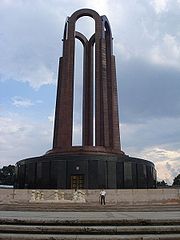
Communist Romania
Communist Romania was the period in Romanian history when that country was a Soviet-aligned communist state in the Eastern Bloc, with the dominant role of Romanian Communist Party enshrined in its successive constitutions...
as the "Monument of the Heroes for the Freedom of the People and of the Motherland, for Socialism" (Monumentul eroilor luptei pentru libertatea poporului şi a patriei, pentru socialism), is located on a plateau. Formerly, it was the site of the Arts Palace (Palatul Artelor) and later of the Military Museum (Muzeul Militar), with the fountain in front of the latter museum.
The mausoleum was built in honour of revolutionary socialist militants. Designed by architects Horia Maicu and Nicolae Cucu, it was inaugurated on 30 December 1963, the 16th anniversary of the Romanian People's Republic.
The base is circular and plated with black granite
Granite
Granite is a common and widely occurring type of intrusive, felsic, igneous rock. Granite usually has a medium- to coarse-grained texture. Occasionally some individual crystals are larger than the groundmass, in which case the texture is known as porphyritic. A granitic rock with a porphyritic...
. Above rise five narrow arches covered with red granite. Inside the base there is a rotunda covered in red granite plates; the ceiling is decorated with a golden mosaic
Mosaic
Mosaic is the art of creating images with an assemblage of small pieces of colored glass, stone, or other materials. It may be a technique of decorative art, an aspect of interior decoration, or of cultural and spiritual significance as in a cathedral...
. Prior to the Romanian Revolution of 1989, the rotunda contained the crypt
Crypt
In architecture, a crypt is a stone chamber or vault beneath the floor of a burial vault possibly containing sarcophagi, coffins or relics....
s of Communist leaders Petru Groza
Petru Groza
Petru Groza was a Romanian politician, best known as the Prime Minister of the first Communist Party-dominated governments under Soviet occupation during the early stages of the Communist regime in Romania....
, Gheorghe Gheorghiu-Dej
Gheorghe Gheorghiu-Dej
Gheorghe Gheorghiu-Dej was the Communist leader of Romania from 1948 until his death in 1965.-Early life:Gheorghe was the son of a poor worker, Tănase Gheorghiu, and his wife Ana. Gheorghiu-Dej joined the Communist Party of Romania in 1930...
and Constantin Ion Parhon
Constantin Ion Parhon
Constantin Ion Parhon was a Romanian neuropsychiatrist, endocrinologist and politician. He was the President of the Provisional Presidium of the People's Republic of Romania from its proclamation on December 30, 1947 to April 13, 1948, and Chairman of the Presidium of the Great National Assembly...
. In the semicircle around the monument were crypts containing the remains of a number of socialist militants, such as Ştefan Gheorghiu (trade unionist), Ion C. Frimu, Leontin Sălăjan, Alexandru Moghioroş, Lucreţiu Pătrăşcanu
Lucretiu Patrascanu
Lucreţiu Pătrăşcanu was a Romanian communist politician and leading member of the Communist Party of Romania , also noted for his activities as a lawyer, sociologist and economist. For a while, he was a professor at Bucharest University...
(after his rehabilitation), Grigore Preoteasa
Grigore Preoteasa
Grigore Preoteasa was a Romanian communist activist, journalist, and politician, who served as Communist Romania's Minister of Foreign Affairs between October 4, 1955 and the time of his death.-Biography:...
, Ilie Pintilie
Ilie Pintilie
Ilie Pintilie was a Romanian communist railroad worker and activist of the Romanian Communist Party .Pintilie joined the labour movement as an apprentice at the CFR workrooms in Nicolina-Iaşi, and became a member of the then-outlawed PCR in 1926...
and Constantin Dobrogeanu-Gherea
Constantin Dobrogeanu-Gherea
Constantin Dobrogeanu-Gherea was a Romanian Marxist theorist, politician, sociologist, literary critic, and journalist....
. To the right of the monument was a hemicycle containing the funeral urns of Communist militants, including Gheorghe Vasilescu-Vasia, Constantin David
Constantin David
Constantin David is a Romanian boxer who competed in the 1936 Summer Olympics.In 1936 he was eliminated in the first round of the lightweight class after losing his fight to Mario Facchin.-External links:* *-References:...
, Ada Marinescu, Panait Muşoiu, Barbu Lăzăreanu, Simion Stoilow
Simion Stoilow
Simion Stoilow or Stoilov was a Romanian mathematician, creator of the Romanian school of complex analysis, and author of over 100 publications.-Biography:...
and Mihail Macavei.
When it was built, an eternal flame
Eternal flame
An eternal flame is a flame or torch that burns day and night for an indefinite period. The flame that burned constantly at Delphi was an archaic feature, "alien to the ordinary Greek temple"....
burned on an upper terrace near the monument, in a granite amphora
Amphora
An amphora is a type of vase-shaped, usually ceramic container with two handles and a long neck narrower than the body...
. This was intended to preserve the memory of those who had fought on behalf of the working class
Working class
Working class is a term used in the social sciences and in ordinary conversation to describe those employed in lower tier jobs , often extending to those in unemployment or otherwise possessing below-average incomes...
.
In 1991, the mausoleum acquired a new purpose when the Communists were exhumed and interred in other cemeteries. They were replaced by the remains of soldiers fallen in World War I
World War I
World War I , which was predominantly called the World War or the Great War from its occurrence until 1939, and the First World War or World War I thereafter, was a major war centred in Europe that began on 28 July 1914 and lasted until 11 November 1918...
, brought from the Mărăşeşti
Marasesti
Mărăşeşti is a small town in Romania in Vrancea County. It is north of Focşani. It administers six villages: Călimăneşti, Haret, Modruzeni, Pădureni, Siretu and Tişiţa.King Milan I of Serbia was born in Mărăşeşti on 22 August 1854....
Mausoleum. The mausoleum and the monument in front of it were dedicated to the Unknown Soldier
Tomb of the Unknown Soldier
Tomb of the Unknown Soldier refers to a grave in which the unidentifiable remains of a soldier are interred. Such tombs can be found in many nations and are usually high-profile national monuments. Throughout history, many soldiers have died in wars without their remains being identified...
. The rotunda
Rotunda (architecture)
A rotunda is any building with a circular ground plan, sometimes covered by a dome. It can also refer to a round room within a building . The Pantheon in Rome is a famous rotunda. A Band Rotunda is a circular bandstand, usually with a dome...
remains closed to the public, and guards are stationed to prevent the approach of visitors.
In 2005, 1.97 billion old lei
Romanian leu
The leu is the currency of Romania. It is subdivided into 100 bani . The name of the currency means "lion". On 1 July 2005, Romania underwent a currency reform, switching from the previous leu to a new leu . 1 RON is equal to 10,000 ROL...
from the state budget were allocated to refurbish the monument, even though it was removed from the list of historic monuments in 2004.
Gogu ConstantinescuGeorge ConstantinescuGeorge Constantinescu was a Romanian scientist, engineer and inventor. During his career, he registered over 130 inventions. He is the creator of the theory of sonics, a new branch of continuum mechanics, in which he described the transmission of mechanical energy through vibrations.Born in...
bridge
Concrete bridge in Carol Park, Bucharest, designed by G. Constantinescu and erected in 1906.Giants' Statues
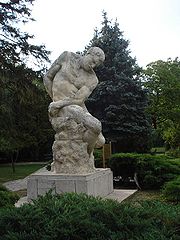

At first the statues were located before the Arts Palace and of the artificial cave in front of it. The grotto was called "The Giants' Grotto" (Grota cu Giganţi) or "The Enchanted Grotto" (Grota fermecată) as it was watched over by the two giants and a Sleeping beauty (Frumoasa adormită). The three statues showed the characters of a legend where a pair of twins, in love with the same woman, were turned into stone due to their unrequited love, while the object of their love became a waterfall. At that time, the giants were displayed one before the other, with the sleeping beauty lying down in the middle.
Filip Marin sculpted Sleeping beauty; Dumitru Paciurea and Frederic Stork were responsible for the giants. The former was done in marble
Marble
Marble is a metamorphic rock composed of recrystallized carbonate minerals, most commonly calcite or dolomite.Geologists use the term "marble" to refer to metamorphosed limestone; however stonemasons use the term more broadly to encompass unmetamorphosed limestone.Marble is commonly used for...
; the latter are in Rousse
Rousse
Ruse is the fifth-largest city in Bulgaria. Ruse is situated in the northeastern part of the country, on the right bank of the Danube, opposite the Romanian city of Giurgiu, from the capital Sofia and from the Bulgarian Black Sea Coast...
stone.
Controversy
The park drew national attention in 2003 when the Romanian government agreed to allot 52,700 m² to the Romanian Orthodox ChurchRomanian Orthodox Church
The Romanian Orthodox Church is an autocephalous Eastern Orthodox church. It is in full communion with other Eastern Orthodox churches, and is ranked seventh in order of precedence. The Primate of the church has the title of Patriarch...
for the "Cathedral of National Redemption" project. The cathedral, although popular among the citizenry and supported by the government, drew criticism because it was to be placed on the site of the mausoleum.
Symbolically, replacing the mausoleum with a church was seen by some as a removal of painful memories, similar to the removal of other communist statues and symbols. On the other hand it was argued that it served as a reminder of Romania's fight for democracy. In addition, the building was seen as an architectural monument and drew the protests of Romanian architects. The cathedral site has since been moved next to the Palace of the Parliament.
